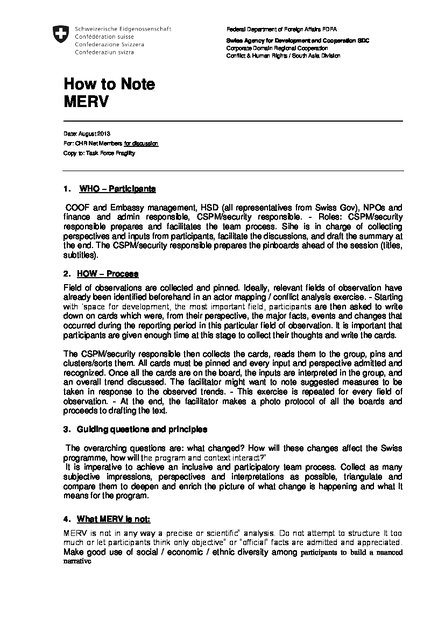
1. WHO – Participants COOF and Embassy management, HSD (all representatives from Swiss Gov), NPOs and finance and admin responsible, CSPM/security responsible. - Roles: CSPM/security responsible prepares and facilitates the team process. Sihe is in charge of collecting perspectives and inputs from participants, facilitate the discussions, and draft the summary at the end. The CSPM/security responsible prepares the pinboards ahead of the session (titles, subtitles).
2. HOW – Process Field of observations are collected and pinned. Ideally, relevant fields of observation have already been identified beforehand in an actor mapping / conflict analysis exercise. - Starting with ‘space for development, the most important field, participants are then asked to write down on cards which were, from their perspective, the major facts, events and changes that occurred during the reporting period in this particular field of observation. lt is important that participants are given enough time at this stage to collect their thoughts and write the cards. The CSPM/security responsible then collects the cards, reads them to the group, pins and clusters/sorts them. All cards must be pinned and every input and perspective admitted and recognized. Once all the cards are on the board, the inputs are interpreted in the group, and an overall trend discussed. The facilitator might want to note suggested measures to be taken in response to the observed trends. - This exercise is repeated for every field of observation. - At the end, the facilitator makes a photo protocol of all the boards and proceeds to drafting the text.
3. Guiding questions and principles The overarching questions are: what changed? How will these changes affect the Swiss programme, how will the program and context interact?“ lt is imperative to achieve an inclusive and participatory team process. Collect as many subjective impressions, perspectives and interpretations as possible, triangulate and compare them to deepen and enrich the picture of what change is happening and what lt means for the program.
4. What MERV is not: MERV is not in any way a precise or scientific“ analysis. Do not attempt to structure lt too much or let participants think only objective“ or “official“ facts are admitted and appreciated. Make good use of social / economic / ethnic diversity among participants to build a nuanced narrative
